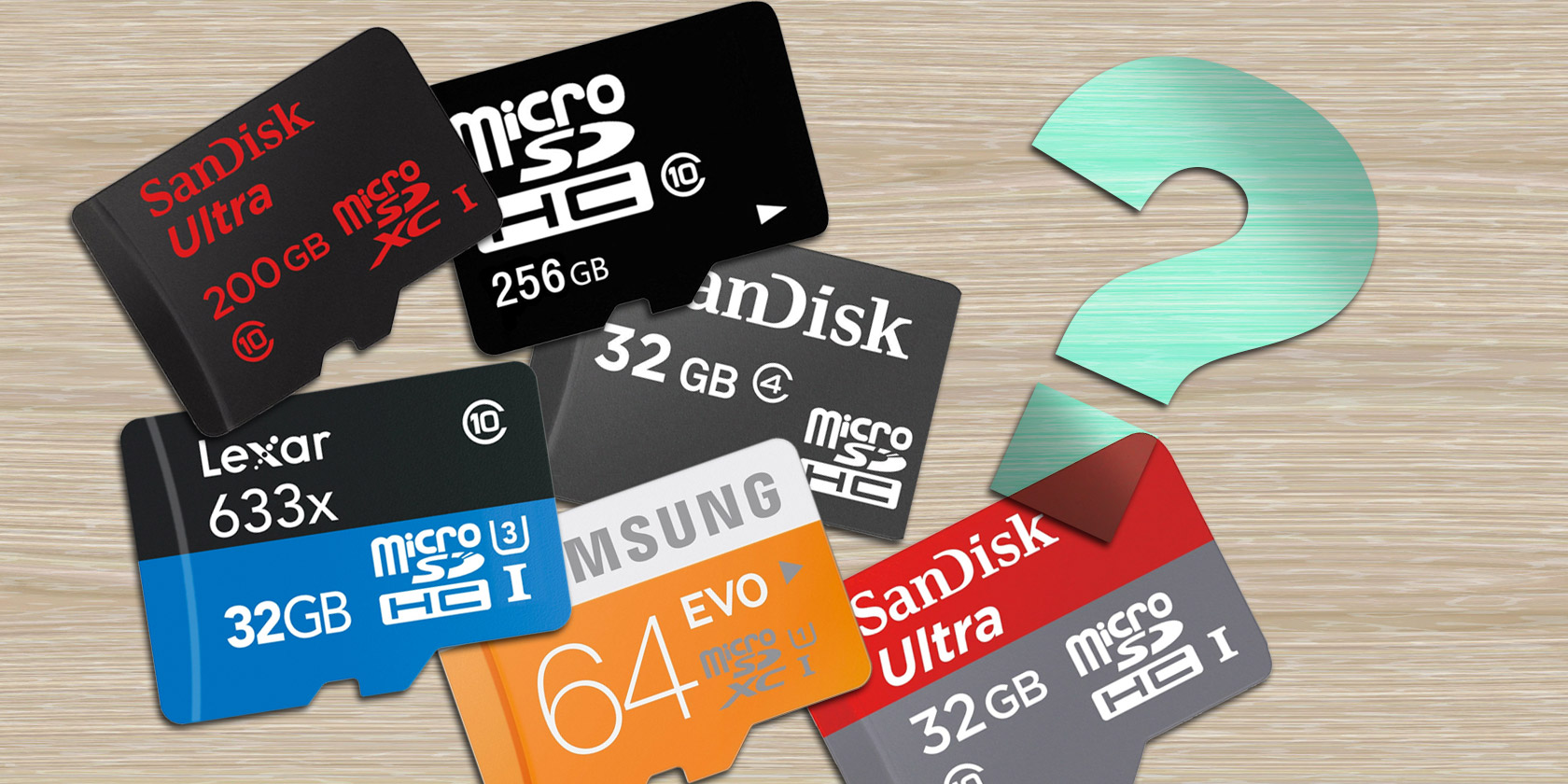
Whether you need it for a phone, a camera, or some other gadget, shopping for a microSD card seems like a pretty simple thing to do, right?
Yet there’s a lot more to them than you might realize. It’s surprisingly easy to wind up falling into a number of traps: overpaying, getting terrible performance, or the card not working at all.
Let’s take a look at what mistakes you need to avoid when buying a microSD card.
1. Buying Incompatible SD Cards
All microSD cards fit into all microSD card slots, but they don’t all work. There are four different card formats, as well as different standards, and these determine compatibility.
The three main formats, which you’re probably already familiar with, are SD, SDHC, and SDXC (or microSD, microSDHC, and microSDXC—micro and full-size cards are based on the same spec). The fourth format is SDUC. This was announced in June 2018, and it’ll be a while before the cards are available.
Each format is defined in the SD specification, but they don’t work in the same ways. As a result, the formats are not backwards compatible. You cannot use newer cards in hardware that only supports older formats.

The differences between the formats are significant:
- microSD: Has a capacity up to 2GB, and works in any microSD slot.
- microSDHC: Has a capacity of more than 2GB and up to 32GB, and works in hardware that supports either SDHC and SDXC.
- microSDXC: Has a capacity of more than 32GB and up to 2TB (although at the time of writing, 1TB is the largest available card), and is only supported in SDXC-compatible devices.
- microSDUC: Supports cards up to 128TB, and will require a compatible device.
In addition to checking that a card’s format is compatible with your hardware, you need to check a few other details, too.
Capacity
First, hardware that supports microSDXC slots won’t automatically support every size of card in this format. The Samsung Galaxy S9, for example, officially supports cards up to 400GB. There’s no guarantee that your 512GB card will work.

And if you’re planning to use your microSD card with your PC at any point—for example, to move files on and off—you also need to ensure your PC supports the file system that the card is formatted with. MicroSDXC cards use the exFAT system by default. Windows has supported it for over a decade, but macOS only since version 10.6.5 (Snow Leopard).
Ultra High Speed
The SDHC and SDXC formats can support the Ultra High Speed (UHS) bus interface—faster circuitry that enables data to move at a quicker rate. The three versions of UHS are UHS-I (with bus speeds of up to 104MBps), UHS-II (up to 312MBps), and UHS-III (up to 624MBps).
In order to benefit from the increased performance of UHS, your hardware needs to support it. UHS memory cards will work in older slots but with a reduced bus speed of 25MBps.
2. Choosing the Wrong Speed

Identifying the speed of a microSD card is even more complicated than deciphering formats and compatibility. There are no less than six ways to show how fast a card is, and it’s not uncommon for manufacturers to use all of them.
Speed Class
![]()
The Speed Class shows the minimum write speed of a memory card in megabytes per second. There are four Speed Classes defined as follows:
- Class 2: At least 2MBps.
- Class 4: At least 4MBps.
- Class 6: At least 6MBps.
- Class 10: At least 10MBps.
Showing base level performance helps you to identify whether a card is suitable for a specific task. But because it tells you nothing about maximum speeds, it’s technically possible for a Class 2 card to be faster than a Class 6 card. Class 10 cards should always be noticeably faster, though, as they have a bus speed of 25MBps (compared to 12.5MBps on Class 2 to Class 6 cards).
UHS Speed Class

The UHS Speed Class shows the minimum write speed for microSD cards that support the UHS-I, II, and III bus speeds. We’re listing it as a separate category because some manufacturers list both classes on their cards. The two UHS Speed classes are:
- U1: A write speed of at least 10MBps.
- U3: A write speed of at least 30MBps.
Application Performance Class

The Application Performance Class specifies a minimum sustained write speed of 10MBps, along with a minimum random read and write speeds measured in input/output operations per second (IOPS). This guarantees an acceptable level of performance when storing and running Android apps on your card. There are two classes:
- A1: Minimum random read speed of 1500IOPS; random write speed of 500IOPS.
- A2: Minimum random read speed of 4000IOPS; random write speed of 200IOPS.
The Application Performance Class is something you can look at when you’re planning on installing Android apps on a microSD card. It isn’t a necessity, though, as cards without the A-rating may still perform as well, if not better.
Video Speed Class
The Video Speed Class sets a minimum sequential write speed, which is essential when shooting video. The higher the resolution your video, the faster speed you need. There are five classes for video:
- V6: Minimum write speed of 6MBps.
- V10: Minimum write speed of 10MBps.
- V30: Minimum write speed of 30MBps.
- V60: Minimum write speed of 60MBps.
- V90: Minimum write speed of 90MBps.
Rated Speed
While it’s generally safe to assume that a higher Speed Class correlates to faster all-around performance, and UHS cards faster still, some manufacturers also quote a maximum speed for their products.
These speeds are in megabytes per second and help you pick out the absolute fastest cards. The speeds are based on manufacturer tests, however, so they may represent a best case scenario rather than real world performance.

In practice, there are other external factors that will affect read and write speeds. If you’re copying files to your PC, for instance, your PC’s specs—and even the USB cable you’re using—will play a role.
Relative Speed
The other way manufacturers show the speed of their cards is a throwback to the old CD writing days. The original transfer rate for CDs was 150KBps. As drives developed, they would advertise themselves as being 2x, 4x, 16x, and so on, showing how many times faster than 150KBps they were.
You’ll often see microSD cards labelled like this. When a card is described as 100x, it means 100 x 150KBps, which is 15MBps. That speed is, again, under ideal lab conditions.
3. Picking the Wrong SD Card for the Task
When you buy a microSD card, it’s important to pick one that is right for its intended use. This means finding a card that is large enough and fast enough, but not necessarily the largest and fastest card out there. High capacity UHS-II U3 cards often still have a price premium and you won’t always notice the benefits they offer.
If you’re using a microSD card to store apps on your smartphone, then consider one with an Application Performance Class rating. But if you want a card so you can shoot 4K video on your phone, go for size and speed as a priority.

The SD Card Association recommends UHS Speed Class 3 (U3) or better for shooting 4K video. For full HD video, it suggests Class 10, or Class 6 at a push. If your card’s write speed is too slow, it will drop frames and produce stuttering video.
For photography, some users prefer several smaller cards to a single large one so they minimize the risk of losing all of their photos if a card corrupts. If you’re shooting RAW, where files might be 50MB or more, you’ll benefit from having U1 or U3 speeds (but they require at least SDHC format).

And in case you’re wondering, there’s no difference between a full-size SD card and a microSD card in an SD adapter. If your camera only has an SD slot, you can still use a microSD card in it.
4. Buying Fake MicroSD Cards
It sounds like an obvious thing to avoid, but sadly, buying fake memory cards is incredibly easy.
If you find a good deal on branded memory cards from a non-reputable seller, there’s a real risk it may be counterfeit. In fact, a few years ago a SanDisk engineer reportedly stated that as a many as a third of all SanDisk-branded cards were fakes. It’s unlikely that that number has declined since.
The buying guides on eBay include a page on spotting counterfeits due to how common they are. Amazon Warehouse sellers have been accused, too. If you’re buying from a source you’re unsure about, check the reviews first.

Counterfeit cards correctly report the capacity shown on the packaging, but actually contain far less. You won’t notice this until the card fills up unexpectedly quickly.
Use the utility H2testw for Windows, or F3 for Mac and Linux, to check that the cards you already own are genuine.
5. Cheaping Out on Brands
We’ve all owned flash memory cards that have stopped working for no apparent reason. While reliability is generally excellent, microSD cards do fail, and when they do, they’ll take all your data with them.
For this reason, buying cards from big brands is always better than buying no-name cards for cheaper. You can expect better performance, greater levels of reliability, as well as more robustness, with cards routinely protected against shock, water, and even airport X-rays.

You also get things like a lifetime warranty and access to image recovery software. Manufacturers such as Lexar and SanDisk offer this as standard.
What’s Your Perfect MicroSD Card?
So you know how to avoid buying the wrong card. Now all you need to do is figure out what is the right card. What speed do you need for your chosen task, and should you get a massive 400GB card? Our guide to what is the best microSD to buy will help you make your decision.
Read the full article: 5 Mistakes to Avoid When Buying a MicroSD Card




